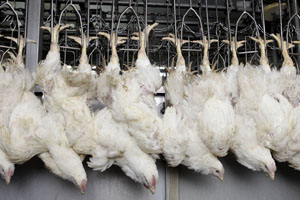Research: Poultry stunning may improve bird welfare

A study conducted by researchers in Scotland and the Netherlands strongly suggests that a new form of poultry stunning is more humane than alternative approaches to rendering birds unconscious prior to slaughter.
In a recent conversation, the paper’s lead author, Dr. Dorothy McKeegan of the Institute of Biodiversity, Animal Health and Comparative Medicine at the University of Glasgow, spoke about some of the factors behind her team’s research on a new approach, called low atmospheric pressure stunning (LAPS):
“Electrical stunning remains the world’s most widely used method of rendering poultry unconscious prior to slaughter. But concerns about stress caused to poultry by shackling prior to electric stunning and variability in its effectiveness have led to legislation that will reduce the use of this approach in Europe and to the investigation of other approaches that may be less stressful to the bird. In our research, we found that LAPS has the potential to improve the welfare of poultry at slaughter by gradually inducing unconsciousness without distress, eliminating the stress of shackling and ensuring that every bird is adequately stunned prior to exsanguination.”
In low atmospheric pressure stunning, poultry are rendered unconscious just prior to slaughter by gradually reducing oxygen tension in the atmosphere. The authors note that since this process raises “legitimate welfare concerns around the experience of birds before loss of consciousness,” the goal of their study was to address these concerns through the collection and analysis of physiological data during the LAPS process, to determine whether there were any indicators of distress to the birds.
Summary of LAPS Study and Findings
To determine whether the LAPS process is stressful, the authors outfitted 28 broiler chickens with wireless, self-contained telemetry logging units to capture high-quality, continuous electroencephalogram (EEG) and electrocardiogram (EKG) data. The data recordings were obtained in a commercial poultry processing plant, which is currently using LAPS.
The researchers found that, based on their EEG analysis, a conservative estimate of the time to loss of consciousness during the application of LAPS was 40 seconds. During this period they noted an increase in slow-wave (delta) brain activity, consistent with a gradual loss of consciousness. The increase in delta wave activity began within 10 seconds of beginning LAPS and continued thereafter. Delta wave activity peaked at 30 seconds into LAPS, at which point it was consistent with the EEG signals of birds under surgical levels of anesthesia.
From the EKG analysis the researchers found that, during the application of LAPS, the birds’ heart rates consistently decreased. They found no instances in which heart rates increased during the period when the birds were potentially conscious. They also observed no behavioral responses that would suggest aversion to the LAPS process.
The authors concluded that “the scientific data strongly suggest that birds do not find LAPS induction distressing,” and that “collectively, the results indicate that LAPS is an effective and humane alternative approach to stunning prior to slaughter.”
The results of the study appear in a recent issue of Poultry Science, a journal published by the Poultry Science Association (PSA), in an article entitled “Physiological Responses to Low Atmospheric Stunning and the Implications for Welfare” (D. E. F. McKeegan et al; 2013 Poultry Science 92 :858–868). The complete article is available here to download.













